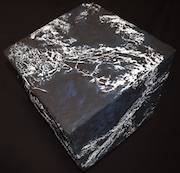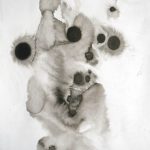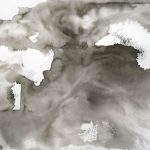For the 15 Questions website, April 2021
History & Influences
Q: You mentioned in previous interviews that you preferred ‘droney’ music in the beginning to calm your mind. Since I’ve heard similar stories before, do you think that a certain mindset, perhaps even a physical attraction to certain frequencies (or a repulsion by others) can lead to a preference for certain tuning systems (and a rejection of, say, Equal Temperament)?
RR: I think my attraction to slower musical styles had more to do with a slightly hypersensitive disposition. The world has always seemed a bit loud to me, and I liked music that could help me journey inside, to a creative place that felt safer. I didn’t think at all about tuning and temperament until I met someone in the late 70s who had recently visited Bali, and had started building his own gamelan instruments. He played me an album of Harry Partch (The World of Harry Partch, on Columbia Masterworks) and it opened up my world. I also found a radio station in Berkeley called KPFA, with a music director Charles Amirkhanian who was friends with many of the composers of new tonal and minimalist music. That’s where I first heard Terry Riley and Lou Harrison. This music just made sense to my ears. It sounded right to me, and it made me want to find ways to tune my instruments. Did I have a special mindset that primed me for that feeling? I really don’t know. I would like to think that anyone might feel attracted to a beautiful new sound.
Q: You’ve spoken a bit about why you were interested in stepping outside of Equal Temperament. But there are, of course, infinite systems other than Just Intonation. Did you explore some of these and why did you, in the end, remain within the realm of JI for your own work?
RR: Just Intonation made the most sense, and it offered the most expressive way to enlarge a harmonic vocabulary while enhancing a sense of tonality. Large EDO tunings are just different types of dissonance. Harmonic-based tunings sound better to me. We live in a time of infinite choices, and I consider it a skill to chose quickly, before I get lost.
Q: Jazz by artists like Sun Ra and Ornette Coleman were early points of interest. I find this interesting, since it was the same for La Monte Young. What did they bring to the table for you? I am also curious if the idea of microtones played a role here. Ornette, for example, did achieve microtonality, even though he did still adhere to the chromatic scale … as did a few other jazz musicians.
RR: I grew up with jazz in the house, mostly my father’s variety of West Coast cool, which I found lacking a certain piquancy, an expressive spice I was seeking. I started exploring the cut-out bins in record stores, finding Chicago Art Ensemble, Sun Ra, Coltrane… My reaction was visceral, not intellectual. Certain DJs at the local college station KFJC would play free jazz, and I fell in love. I remember the revelation upon first hearing Pharoah Sanders’ “The Creator Has A Master Plan.” It froze me, unable to stop listening, almost in tears from Leon Thomas’ yodeling vocal improvisations, the repetition, the optimism, the organized chaos. For me, this music was all about energy. I never thought about intonation in my in response to it. When John Gilmour would solo on tenor sax in Sun Ra’s Arkestra, every note at once in a sort of spiritual orgasm, what is tuning then? Who cares? I saw Sun Ra every chance I could in the 1980s. The Arkestra created a sacred moment, full of energetic celebration, unity and love. Those are the messages I got. Tuning did not matter.
Q: The influence of La Monte Young obviously comes up frequently in connection with just intonation. What influence did he have concretely on you? What’s your take on the importance of “The Well Tempered Piano” and did you ever get to hear it in concert? What about Terry Riley, whose music actually seems to have clearer connections to your own work (at least from my perspective)?
RR: Terry Riley is without doubt my biggest musical influence. Oddly, not so much with La Monte. I never connected emotionally to La Monte’s austere minimalism, although I appreciated the ideas. Recordings of La Monte’s music were very scarce when I was starting. I only could read about them, about the Dream House or Theater of Eternal Music. I liked the concepts but I had no idea how they sounded. On the other hand Terry expressed so much joy through his music, so much warmth. When I did finally get to hear some of La Monte’s music, it had an obsessive quality that didn’t capture me; although I must admit, “Well Tuned Piano” is perhaps a masterwork.
I met La Monte in San Francisco at the home of Henry Rosenthal and Carola Anderson, and he played us a tape of his House of Eternal Blues, with John Catler. That hour-long repetitive blues jam in JI seemed to go on forever. I felt honored to meet him, but I wasn’t left with the best impression. On the other hand, sharing beers with Terry Riley in a pub after one of his concerts left me feeling all friendship and love. We became friends with his son Gyan at a festival we both played in London 20 years ago. Gyan has spent the night with us a few times. I confess I think Terry would have been a rather lovely father to have.
Q: Just out of curiosity, I thought it interesting that Pierre Schaeffer never made an appearance in your list of inspirations. His vision of a world of sound, mostly outside of tuning considerations, and of using the sounds around us as compositional material, seems to bare some some overlaps with your work. Were you never drawn to it?
RR: When I was forming my musical language, as a teenager in the 70s, much of the European and mid-century modernist avant garde left me emotionally cold: Stockhausen, Schaeffer, Henry, Babbit. I was attracted to Cage’s philosophy, not so much his music, and I did like what I could hear of Xenakis, which seemed sensitive and interesting. I was still learning, still young, and just found myself attracted to certain ideas of tonality and improvisation. I listened more to Indonesian gamelan and north Indian raga than I did to Western experimental music. Music of pure sound did interest me, but I wanted it to express a more visceral, earthy direction. I especially felt connected to environmental sound artists like Annea Lockwood, Marianne Amocher or Bill Fontana, whose choices showed a grounded sensibility. Of course we all grow and change through our lives, and I appreciate those early innovators like Schaeffer and Henry much more now.
Q: The way I understood it, you spent considerable time at university studying Just Intonation. Regardless of how fruitful this period was, what were some of the insights you gained that were actually relevant for you? In terms of theory, do you think there are certain things one should know before starting the journey into alternative tuning systems?
RR: My degree at Stanford was in psychology, and the only music classes I took were the computer music courses at CCRMA, for which I technically didn’t qualify. One of my most important insights, was that I got more music done on my poor quality homemade instruments than at CCRMA, because I benefit from limitations. The computer could make almost any sound you could imagine, if you only could figure out how to write the code for it. You needed to describe every gesture in methodic detail. I learned I am better at improvisation and intuitive methods of working. I am tactile. I think with my body, with objects, with physicality, not so much in pure abstraction. Although nobody was teaching tuning theory, I did manage to create a bank of just intonation tuning frequencies using the CCRMA synthesizer, which I then put on a cassette and sold to people (at my cost) along with JI tuning presets for the Prophet 5. I did all that on my own, not as a student. After graduating, I discovered a group of like-mined musicians in the San Francisco area who started the Just Intonation Network, and that taught me a lot.
Regarding the second question: the insights from calculating ratios in just tuning systems leads to a very beautiful sense of geometry and harmonic relations. For brief moments, we glimpse into the mind of Pythagoras, Ptolemy or Kepler. Those fleeting views of symmetry can feel ecstatic. This sense of symmetrical beauty can send newcomers into funny patterns of near-religious fervor. Composers who have been doing this a while start to recognize the recurrent waves of tuning zealots who feel they have discovered that perfect cosmic unification of all things beautiful and truthful, who then start to preach their new invention to a world they consider deaf and blind. I know, I was a bit like that myself back then. I quickly learned some humility when reading articles in the Just Intonation Network newsletter, by composers like Bill Alves, Lou Harrison, David Doty, James Tenney, Erv Wilson. For years they had been paving the road through the jungle opened up by Harry Partch, and I struggled to catch up to their level of knowledge. I still consider myself a beginner.
Besides humility, what I recommend for beginners is to get ready for a lot of fractions if they want to understand just intonation. It’s a great way to get bogged down in basic 5th grade math. I ended up writing my own software “JI Calc” because I got tired of reducing fractions. (My friend Carter Scholz then took it over and made it really good. I still haven’t found other tools that work quite as well for me as that, but computers have evolved so much it’s hard to keep old gear around to run it.) The point is that working in alternate tunings can be tedious, it will slow down the flow and add a level of detail and complexity that risks derailing the creative process. In the end, the music has to be about something other than just tunings. Tunings are a tool, not the final destination.
Just Intonation
Q: Especially your early music drew inspiration from and engaged in a dialogue with animal sounds. At the same time, you were interested in the idea of music as a landscape. I am curious in how you see the relationship between these creative goals and your preference for just intonation. It would seem to me that in nature, we are surrounded constantly by a multitude of sound-producing bodies producing noise and song in an endless array of different tuning systems. So your work seems to relate to a sonic space that is very deeply engrained in our DNA …
RR: Tuning systems are a human construct. Frogs and raindrops don’t think about it. I don’t try to make a connection between the environmental sensibilities in my music and the use of just intonation. They are all components of music I hear deep inside. I feel they convey an honest fabric of existence at this time and place. Those natural sounds entered the music because I have always used sonic landscapes as ways to enhance my sense of being centered in a place. As a teenager I would lie in bed with my windows open late at night, listening to the sounds of rain, frogs, wind, water, birds… using those sounds to journey with my mind out the window and into that secret landscape. Sound lets us hear into a mystery, around corners, into the unseen. For those reasons, these natural sounds are just a part of my music, part of an attempt to disappear. I would never imagine trying to organize everything in our world. Tuned notes have their place, and wild sounds have their place. Composers find ways of fitting elements together that work for them.
Q: In the world of natural sounds, pitch is not as clear a concept as it is in the world of humans. Some of your music, too, plays in a territory, where pitch seems to be a more open concept, if that’s a sensible way of putting it. What’s your perspective on pitch and its role in our sensation of tone?
RR: Not everything in music lives on a grid. I like to have a reference that considers harmonics to be the resting spots. Yet I feel strongly that expressive playing needs to be free of a grid, free of constraints. Sadly we live in a brief time when algorithms like Autotune cause people to think that exact tuning should sound like yodeling robots. Let’s bend our animal voices, add filagree without prison bars. I also love every sound that takes me into a landscape, and all of those insects, amphibians, birds and geology have their own intrinsic tuning systems. Let’s embrace the world around us, and let’s not be fascists about who gets to sing a right or wrong note. Microtonality is about freedom and not about dictatorship. Use the tools that sound the way you want to hear… simple as that.
Q: One of the pieces on your Rainforest album openly references Bach. But I instantly thought of him in connection to your work without prior knowledge of it. Bach lived in a time, where the borders between algebra/geometry, architecture, science, creativity and craftsmanship were far less fixed. Can you talk about what attracted you to Bach? What are the overlaps between these disciplines? And do you feel as though the choice of tuning system is part of a larger approach to music, creativity and even life for you?
RR: Bach’s music attracted me from the moment I heard it, especially some of the delicate filagree such as Glenn Gould’s recordings of the English Suites and the Italian Concerto in F. I feel a physical presence in the air, glowing evanescent floating architecture. I also get that feeling when I hear Javanese gamelan, and some part of my intuition told me they came from a similar place. The only way I could express that feeling was to try to show it directly in a piece of music. That’s why I made “Forest Dreams of Bach.” Like most of my music, the ideas come together intuitively, almost pre-consciously. Then the challenge comes in expressing those ideas in sound. The choices of tuning should serve that feeling. Tunings serve the musical intent: they are choices we give ourselves, and those choices should improve the effect of the outcome, in regards to our intention as artists. For that piece I chose a western-style just intonation that sounded good with the minor key I used, rather than an Indonesian pelog or slendro that would impose a less-western tonality. It could have gone in many directions.
Regarding the boundaries between scientific disciplines and artistic styles: I think those boundaries are never fixed, always fluid, and the reason they seemed more fluid in the Baroque era or Renaissance is that the scientific method was still new, and our detail of knowledge about the natural world was in lower resolution. A person who lived long enough could actually accomplish breakthroughs in multiple areas of inquiry. We have increased that resolution to a point where very few humans can claim expertise in any field, let alone several. The extreme complexity of our knowledge landscape has forced us to specialize if we want to have any influence in a topic. I don’t see this getting any simpler. I think we need art more than ever to humanize us now, to help bridge the divide between our increasingly self-referential technologies and our place on the planet, as organisms who still need to live in a sustainable world.
Q: In Bach’s time, too, the idea of a Harmony of the spheres was still very much respected. Today, it seems to have become mostly the domain of New Age. What’s your own take on it?
RR: I think we look for inspiration wherever we can find it. When an old idea such as Harmonia Mundi offers us a sense of meaning, or a sense of place in the universe, it serves a purpose. The direction each artist choses to express that inspiration will be a personal choice. It doesn’t really matter what people call it. I suppose we lump it into New Age if the composer avoids the shadows and keeps the music more frothy and pretty. People also differ in their assumptions about what we can or cannot expect music to do, to the listener. Some artists operate on the idea that their art could actually contain intrinsic healing powers, medicinal or spiritual qualities; other artists might approach these questions with more humility, or an awareness that context and cultural expectations will influence the way people respond to art. I suppose I am a bit of a modernist in that I tend to fall in the second category, although I do have a Romantic side that wishes the first category were possible. In any case, if a modern work of art references fractals, quantum physics, or molecular genetics… isn’t that a bit like Harmonia Mundi in 1650? What will people think of those ideas in 400 years?
Q: Numerical relations play a large role for many composers working with Just Intonation. As you’ve stated, they need (or should) not be apparent for the listener. But what role do they concretely play in terms of your process?
RR: I use the tunings to help make the music more expressive, more intense. The tunings give me more colors in my paint box. Sometimes I get inspired simply by the sound of a chord or interval, and it pulls me forward into the process of making.
Q: I wanted to get a bit deeper into the compositional specifics of what attracted you to Just Intonation. You once said: “How about a melody line that plays hide-and-seek around the harmonics of another note? At last, harmony and timbre can merge. Indeed, one of the most satisfying aspects of just intonation is the fact that harmony suddenly makes sense.” Could you elaborate on that a little bit, also in the light of your own creative practice?
RR: The word “harmony” contains the root of the answer. Harmony is based on harmonics, and just intonation is simply tuning the chords correctly, based upon whole-numbered ratios between frequencies, ratios between harmonics. Of course the notes in a scale no longer fit well on the exponential curve, so it has shortcomings in regards to modulation. What it gives you in return is a much deeper insight into why chords sound like they do. Once you start to hear how smaller numbers in the ratios create simple sounding intervals (octave 2/1, fifth 3/2, fourth 4/3 for example) while larger numbers create more complex sounding intervals (7/5 or 15/14 for example) it connects the sound to a reasonable mechanism to understand harmonic complexity. Any interval with a power of two in the denominator will be part of the harmonic series (11/8, 7/4 for example), so those notes will sound especially pure and can merge into the timbre of other instruments. Those are the ones that “play hide and seek”. I often use the upper parts of a harmonic series tuning for sound design, sweeping the notes quickly to create shimmering chromium ribbons, like in the opening parts of “Electric Ladder” or “Neurogenesis.” That’s where tuning and sound design merge.
Q: Are there differences in terms of mastering and mixing your music in Just Intonation compared to works in ET? I’m thinking about the way different frequencies behave here ….
RR: Normally, I would say that I have the same concerns with mixing or mastering anything – striving for balance, openness, dynamics, deep lows and silky highs… normal things. However I have occasionally run into challenges when the tunings result in very strong ghost tones in the fundamentals of the tuning. This happened on a few pieces on Neurogenesis, such as on the opening title track, which is in a harmonic series tuning. That lends itself to a very strong reinforcement at the fundamental and its octaves. As the fundamental on that is 55Hz, this created a lot of energy in difference tones at 110, 220 and 440. I needed to subtract quite a lot at 440 to make it work as an overall mix. That sort of situation isn’t very common, but shows that different approaches might prove necessary when strong ghost tones might dominate a mix.






You must be logged in to post a comment.